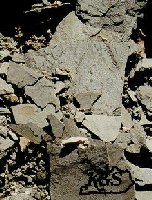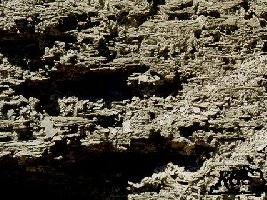Shale
Shale is the most abundant of all sedimentary rocks. It is composed primarily of soft clay minerals, but may include variable amounts of organic matter, calcareous material, and quartz grains. Shale may be any color, but is generally greenish gray to grayish black. It is relatively soft and has a smooth, greasy feel when freshly exposed, but is hard and brittle when dry. Most shales split into thin plates or sheets and are termed fissile, but others are massive (nonfissile) and break into irregular blocks. Shales weather very easily to form mud and clay. Numerous secondary minerals are associated with shales, including melanterite, copiapite, and halotrichite, which are described in Minerals.
The most prominent shale in Kentucky is the Chattanooga (also called New Albany and Ohio) Shale, which crops out in southern Kentucky and around the Knobs Region. It is brownish black, silty, pyritic, bituminous, and carbonaceous. This Chattanooga black shale contains sufficient organic matter to burn, and several attempts have been made to mine this oil shale as a fuel source.
The New Providence and Nancy Shales of Mississippian age, which also crop out in south-central Kentucky and around the Knobs Region, are used in the brick industry of Kentucky. These shales are a bright green to greenish gray, relatively soft, plastic clay-shale.
Go Back to Sedimentary Rocks

